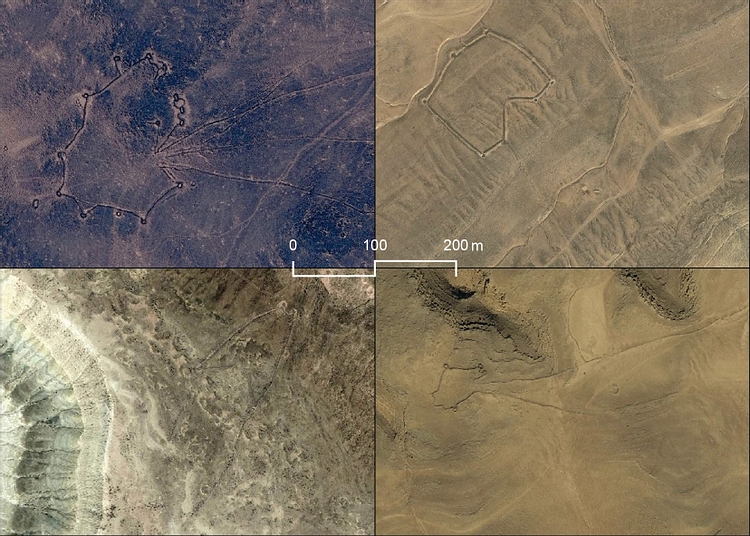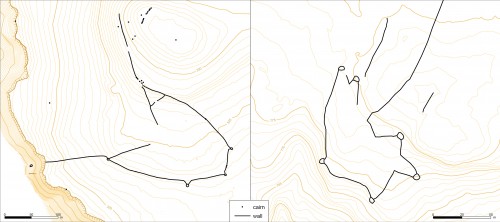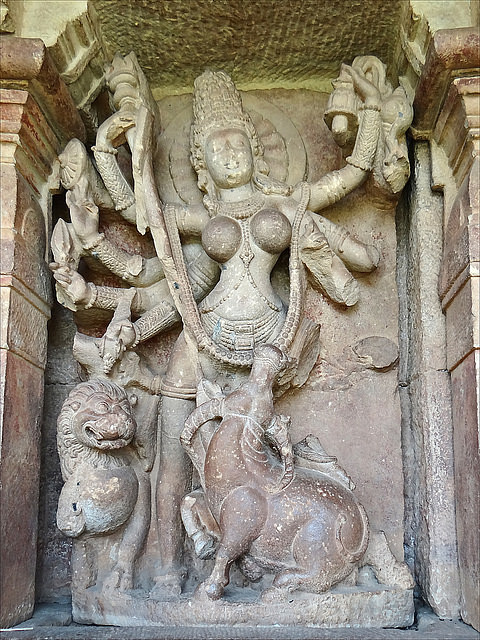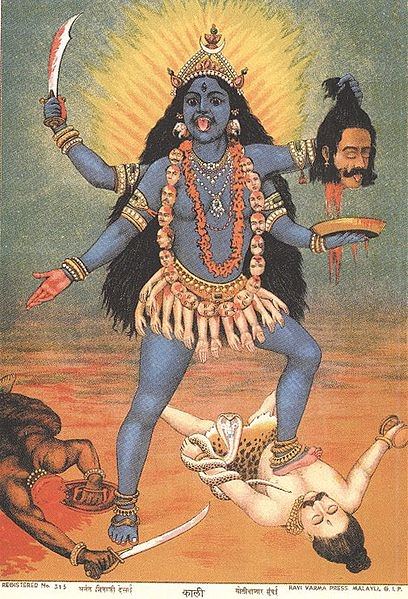Desert Kites › Devi › Ptolemy's Letter to Flora » Origins and History
Articles and Definitions › Contents
- Desert Kites › Origins
- Devi › Who Was
- Ptolemy's Letter to Flora › Origins
Ancient civilizations › Historical places, and their characters
Desert Kites › Origins
Definition and Origins

Desert kites are constructions that consist of two long walls converging upon an enclosed space that has on its periphery small stone constructions called cells. Seen from the sky, their shape suggests that of a windborne kite; they were thus called kites by pilots who flew over the arid regions of the Near East in the time of the French and British mandates of the first half of the 20th century CE. These kites combine various characteristics, which in archaeology have been the object of particular research. However, most methods of investigation are useless because of the nature of these constructions.
In spite of many studies, and although it is possible to advance several serious hypotheses, no one can confirm with certainty today the age or function of these structures or the culture which they represent! (It is generally agreed that they served to gather animals together, but whether they were used for wild or domesticated animals is uncertain.) Moreover, recent access to high-resolution satellite images has revealed that there are many more kites than were thought a few years ago, over an area that extends from the Arabian Peninsula to the Aral Sea. Thus, piercing the mystery of the “kites phenomenon” involves avenues of research that have implications for questions as fundamental and diverse as animal economy, disappearance of species, development of subsistence territories, and even the development of urbanism.
PETROGLYPHS REPRESENTING KITES HAVE BEEN FOUND, BUT IT IS NOT CLEAR WHETHER THEY ARE HUNTING OR PASTORAL SCENES. IN FACT, WE KNOW NOTHING OF HOW A KITE FUNCTIONED.
MORPHOLOGICAL DESCRIPTION
Kites are composed of an enclosure of variable shape and size and more or less continuous walls that converge towards the entrance; these walls can sometimes be absent but are usually two in number and sometimes three, four, or more. Their length is commonly several hundred meters and can even reach several kilometres, while their height is no more than a few decimetres. The enclosures are variable in shape (circular, triangular, star-shaped…), and their size, larger than the majority of pastoral enclosures, varies from a few hundred square meters to more than ten hectares.
The small stone constructions or cells that are joined to the external part of the enclosure have walls that are often higher than those of the enclosure. They are circular or quadrangular in shape and their number varies from a single cell to several dozen.If several often-observed particularities are considered, such as a disposition of the cells near the entrance, the existence of cells at the extremity of pointed appendices and the particular shapes of the entrance, the variability among the kites makes it difficult to propose a typology. Kites are found in arid environments, steppes, and desert margins, and their topographical location is clearly the result of a definite choice in many cases. A break in the slope is very often observed at the position of the entrance and various topographic configurations were preferred to flat topography.

Example of kite
GEOGRAPHICAL DISTRIBUTION
The principle of an enclosure at the extremity of converging walls appears to be universal in character, as constructions of this type are found in several regions of the world (North and South America, Scandinavia, etc.) in terrestrial as well as aquatic environments. However, kites are distinguished from other constructions by the presence of cells adjoining the enclosure.
The first kites identified, and the most numerous, are located in the Harrat-al-Sham, between Syria and Jordan. There are other zones of high density, but these are more circumscribed: in the Palmyrenides in Syria, in the Hejaz near Khaybar, and recently discovered in Armenia. Other regions contain kites that are more dispersed, although they are rarely isolated and are usually grouped together: in the regions of Damascus and Qaratein, in the Jebel al Has, and on the plateau of Hemma in Syria.
In Arabia, they are also found in the northern margins of the Nefud, in the prolongation of the Harrat al-Sham. An important group was recently discovered in the southern foothills of the Taurus in southern Turkey. Another important group, long known to Russian archaeologists, is situated on the plateau of Ustyurt, in the Aralo-Caspian zone. Finally, there are two small groups of related constructions which are generally called kites, but with very particular morphological features: one in the Negev, the other in the region of Marib in Yemen. In total, the most recent inventory (summer 2014) includes more than 4500 kites.

The distribution of kites
FUNCTION
It is generally agreed that kites served to gather together animals. But opinions are divided on the question of whether the herds were wild or domestic. The hypothesis of hunting prevails, although the pastoral hypothesis has not been refuted. In favour of the first is the known use for hunting of the small traps of the Negev, particularly well-studied but not numerous and quite unusual. Moreover, several elements would appear to lend themselves to the practice of hunting, such as the presence of a break in the slope at the entrance to the enclosure which probably served to mask the latter from the animals before they entered it. Similarly, certain regions present kites that are organised in chains, all oriented in the same direction, which would correspond to the hunting of animals on migration.
Finally, a deposit of gazelle bones containing many individuals of different age and sex, indicating massive non-selective hunting, has been discovered some ten kilometres from a series of kites in north-eastern Syria. This discovery is intriguing, but proves nothing concerning the use of kites, even less their role in the disappearance of the great herds. Petroglyphs representing kites have also been found, but it is not clear whether these should be interpreted as hunting scenes or pastoral ones. In fact, we know nothing of how a kite functioned. In particular, we do not know the purpose of the little cells, although they appear to have been essential, to judge by their omnipresence and the care taken in their construction; they could have served as hides, as pits, or even as domestic spaces.

Example of cell
DATING
In spite of several studies on the subject of the age of the kites, only a few indices have been found. There are problems of methodology, as archaeological material is generally absent. Excavations have not produced the remains of tools, traces of use, or animal bones, while carbonised materials suitable for dating are rare. Material scattered on the surface can sometimes be recovered, but this rarely concerns a particular period or use and does not present a spatial distribution suitable to establishing a relationship with the kite.
There is one notable exception: a significant number of dates established (radiocarbon on charcoal, IRSL of sediments and examination of artefacts) for several traps in the Negev demonstrate use centred on the early Bronze Age. Unfortunately, these structures, of a very particular size and morphology, are few and relatively detached spatially from the other kites of the region; neither the age nor the function of kites can be established based on such particular examples.
For all the other kites, that is, almost all the corpus, we have only a few clues. In chronological order:
- Based on relative chronology and/or on artefacts found on the surface, two authors are in agreement that the kites of the Harrat al-Sham in Jordan correspond to the end of the Neolithic ;
- In southern Syria, the excavation of a kite and cross-checking with relative dating has enabled its dating to the beginning of the early Bronze Age;
- On the basis of rock engravings depicting kites, those in north-eastern Syria could date to the early Bronze Age;
- In Armenia, based on a series of absolute (radiocarbon) and relative evidence, it could be established that the kites were used between the beginning of the Bronze Age and the change of era;
- The well-known Safaïtic engraving on the cairn of Hani suggests the use of kites in the Roman period;
- Based on various evidence (including recent radiocarbon dating), the use of some kites in the Aralo-Caspian zone goes back to the Iron Age and persisted to the sub-contemporary period;
- We have several travellers' accounts of between the 17th and 19th centuries who describe collective hunting of gazelles in the Near East, but it is not certain that the structures described correspond to the kites we observe today.
This evidence, low in quantity and sometimes unsure, appears to indicate long-term use. However, these indications are very scattered across the area of distribution which besides shows a great morphological diversity. In the present state of the available data, it is not possible to propose a simple and clear chronology.
Devi › Who Was
Definition and Origins

Devi, also known as Mahadevi or 'Great Goddess', is an all-embracing Mother Goddess first worshipped in India in Prehistoric times. In the Vedic period, she was assimilated into the Hindu pantheon and so came to represent the female energy or Sakti (Power) of her husband Shiva. Both Devi (meaning goddess in Sanskrit ) and Sakti may also be used more generically to reference any female Hindu goddess, especially Parvati, Lakshmi, and Sarasvati. Devi is most often manifested as the fearsome female warriors Durga and Kali, both of whom famously killed a number of terrible demons in Hindu mythology. Devi is also the mother of Nandi, Shiva's doorkeeper and bull; Skanda, the six-headed god; and Ganesha, the elephant-headed god.
Devi's character has two opposing sides represented by various separate female deities: as Uma, the benevolent, and as Durga, the terrible. It is as the latter, more fierce personification that she is most frequently worshipped. Her dark side can also take the form of the fearsome black goddess Kali. The deity has a myriad of many other names and may, for example, also be referred to as Vindhyavasini, Kanya (the Virgin), Mahamaya (the Illusion), and Bhutanayaki, the queen of the Bhuta, those ghosts and goblins who haunt graveyards, make the dead live again, and trick the living so that they might feast on their flesh.
THE TWO SIDES OF DEVI: UMA & DURGA
Devi's more benevolent side is worshipped as Uma, and this facet of her character is represented as both beauty and light.This softer side is also referred to as Jaganmata (Mother of the World), Gauri (Yellow and Brilliant or Golden), Bhavani, Haimvati, and Parvati (the Mountaineer).
DEVI'S DARK SIDE IS THE TERRIBLE DURGA WHO HAS TEN ARMS, AN IMPRESSIVE ARMOURY OF WEAPONS, AND WHO RIDES A MAGNIFICENT LION.
Devi's dark side is represented as the terrible Durga (the Inaccessible) who has ten arms, an impressive armoury of weapons, and who rides a magnificent lion or tiger. This side is further manifested in the forms of Kali, Kalika or Syama (the Black Goddess); Candi or Candika (the Fierce), in which guise she killed many a demon or asura; and Bhairavi (the Terrible).Worshippers of this face of Devi seek her favours and dark powers and so make blood sacrifices and perform wild rituals in the ceremonies of Durga-puja, Carak-puja, and the Tantrikas which call on Durga's sexual and magical powers.
DEVI SLAYS MAHISA
Devi appears in various episodes of the Mahabharata, the Puranas, and other, later, Hindu religious texts. One of Devi's most famous mythological escapades is her slaying of Mahisa, the demon who had the body of a man and the head of a buffalo, as told in the epic poem the Candipat ( or Candi-mahatmya ), which is part of the Skanda Purana. Ambitious Mahisa wanted to take over the world, no less, and so led an army of demons to wage a 100-year battle with the gods. Doing rather well, Mahisa managed to kick most of the gods out of heaven, forcing them to wander the earth as mere men.
Eventually, the situation got so bad that Brahma gave a rousing speech to his fellow gods Vishnu and Shiva during which he told of Mahisa's great mischief. Outraged, the two great gods became so furious that divine fire blazed from their mouths. At the same time, fantastic energies came forth from the similarly indignant bodies of Indra, Yama, and all the other gods.Swirling around heaven, this tremendous energy condensed into a single mass and formed the terrible goddess Durga. As with many Hindu tales, this is but one version of Durga's birth. In other versions, Devi has already long existed as the daughter of Himavat, the personified deity of the Himalaya Mountains, and in this episode she is only given weapons by the angered gods. These arms include a discus, trident, bow, sword, dagger, harpoon, and a noose
Durga is given the task of seducing and then killing the troublesome Mahisa. Hiding herself in a refuge on the sacred Blood-red Mountain (aka Tawny Mountain) and spending her time performing acts of asceticism, the goddess set four young boys as guards, one on each face. Mahisa's followers came across these guards and wondered just who they were protecting.Disguised as birds, they managed to access the sanctuary and so caught sight of the lovely goddess. Returning to Mahisa, they aroused his desire to possess Durga. Accordingly, he disguised himself as an old man and so gained access to the refuge. Mahisa then revealed himself and boasted of his tremendous wealth and power so that Durga might be persuaded to marry him. Durga's somewhat dismissive response to this proposal was to transform herself into fire. Then, riding her lion, she swung her formidable array of weapons, but Mahisa wisely fled the scene to fight another day. The goddess would have to employ more subtle means to rid the world of the buffalo demon.
Durga and Mahisa soon met again on the battlefield in a terrible clash which shook the mountains. The problem for Devi was that whenever she tried to strike Mahisa with a fatal blow he transformed into another creature - from a buffalo to a man to a lion, then to an elephant and back to a buffalo. At this moment, the goddess pounced and, straddling the creature, stabbed him in the neck with her trident. At this, the spirit of Mahisa came out of the mouth of the dying buffalo and Durga finally killed him by lopping off his head. From the heavens there then came a tremendous roar as the gods rejoiced at the fall of this awful demon.

Kali
WORSHIP
The goddess is particularly worshipped by Shaktism and Shaivism, denominations of Hinduism. She is revered at Vindhyavasini, near the Ganges in Uttar Pradesh and the goddess often takes that name. This is the point where the Vindhyas Mountains meet the sacred river Ganges. A statue of the goddess there is perpetually offered fresh blood. Durga is also worshipped in the nine-night festival Navaratri which is celebrated across India and Nepal.
REPRESENTATION IN ART
As Durga, the goddess is most frequently portrayed as a beautiful yellow woman riding her lion. As Kali, she has a black skin and terrible features which drip with the blood of her victims. As the Black Goddess, she also wears snakes and garlands made from skulls and decapitated heads.
Durga slaying Mahisa is a popular subject in Hindu art. One of the earliest representations is in a cave temple near Mallapuram dating to the 7th or 8th century CE and on the mid-8th century CE Kailasanatha temple at Ellora. In the latter relief sculpture, a four-armed Durga rides her prancing lion which stomps over Mahisa's followers while the goddess faces the Buffalo Demon brandishing her array of weapons. The earliest shrine dedicated specifically to Devi is found at Cidambaram and dates to the 12th century CE.
Ptolemy's Letter to Flora › Origins
Ancient Civilizations
Although many Christians, theologians, and denominations have advocated for the idea that all biblical texts within the canon are one in spirit, authority, and ultimate authorship, not every reader of the Bible has come to the same conclusion, historically.During the formation of the early Christian church, some heterodox readers suggested that there was a potential juxtaposition between the God of the New Testament and the God of the Old Testament. As Harland states,
At this time, more and more Christians came from a non-Jewish background, and Christian theologians began to measure themselves against the teachings of secular Hellenistic philosophy. Many branches of Christianityhad to face this issue, the Gnostics no less than any other. (Harland, 306)
One such person was Ptolemy the Gnostic (also known as Ptolemaeus Gnosticus), who studied under the famous Gnostic teacher, Valentinius (c. 100 – c. 160 CE) and wrote a fascinating letter to his sister, Flora, discussing the integrity and authority of the scriptures.
LETTER TO FLORA
Unlike the traditionalist view that holds that everything in the Bible is inspired of God (and therefore supremely equal in value), Ptolemy, like the Gnostics, considered some texts more godly than others; his interpretation followed "the principles of a Gnostic view of reality" (Froehlich, 12). Their approach to the scriptures was very hierarchical with some scriptures countering others in regards to their authorship or origin. As these Gnostics read the scriptures, it appeared to them that some commands and ordinances were frequently in conflict, indicating possible corruption of the biblical texts. Thus, they were perplexed about how to correctly interpret or assign words to/of God.
Ptolemy wrote a letter to his sister, Flora, in which he detailed how he thought the New and Old Testament texts should be evaluated. To him, the scriptures that came from God in the New Testament was profoundly more authoritative than the Old Testament (even though it, too, had God's touch upon it). He writes,
The Law of God, pure and not mixed with inferiority, is the Decalogue, those ten sayings engraved on two tables, forbidding things not to be done and enjoining things to be done. These contains pure but imperfect legislation and required the completion made by the Savior. (Froehlich, 40)
However, unlike the New Testament texts, which he claimed came straight from the good God, the Old Testament texts were often tainted by human influence (or the Demiurge or Demiourgos ), which lessened their importance.

Moses Recieves the Law
Challenging the radical literary critics, He writes, "For some say that it [the Mosaic Law] was laid down as law by God the Father. Others, however, leaning in the opposite direction, insist that it was ordained by the adversary, the destructive devil...Both sides are completely wrong" (Froehlich, 37). Ptolemy believed that the Old Testament law was a composite text created with authorship from God, Moses, and the elders of the people. God provided the Ten Commandments, Moses added to them to diminish the amount his people could sin, and the elders took over and changed it still, "legislating contrary to God" (Froehlich, 39).
CLASSIFICATION OF GOD'S LAWS
The true, good law was the one Jesus Christ purportedly received from God and handed to humanity in the New Testament.Supporting this position, Ptolemy states, "We shall draw the proofs of our statements from the words of our Savior, which alone can lead us without stumbling to the comprehension of that which is" (Froehlich, 38). Furthermore, showing his Gnostic influences, Ptolemy goes on to suggest that even God's laws can be divided into three hierarchical groups based on the opposition of spirit and flesh.
ACCORDING TO PTOLEMY, THE TRUE, GOOD LAW WAS THE ONE JESUS CHRIST PURPORTEDLY RECEIVED FROM GOD AND HANDED TO HUMANITY IN THE NEW TESTAMENT.
The first he deemed, "pure legislation" (Froehlich, 40) because it was not "entangled with evil" (Froehlich, 40) and was fulfilled through Jesus Christ. The second he considered "the legislation entangled with the inferior and with injustice" (Froehlich, 40) because it dealt primarily with inter-human relationships and which was "abolished because it was incongruous with his [Christ's] nature" (Froehlich, 40). The third group was made up of spiritually symbolic precepts that Jesus "transferred from the realm of sense perception and appearance to the realm of the spiritual and the invisible" (Froehlich, 40).
These were laws that had been metamorphosed into higher, grander ideals than they previously possessed. Thus, instead of circumcision of the flesh, after Jesus, one needed to experience the circumcision of the heart. As Ptolemy continues, the reader can sense a growing dichotomy between the Old Testament and the New Testament. Instead of one unified God made up of Father and Son, for the Gnostics, there existed a clear separation of deities and spiritual powers at work on the earth.
DEMIURGE
Controversial early church leaders like Ptolemy, Valentinius, and Marcion of Sinope (ca. 85 – ca. 160 CE), began to divide the scriptures as to what was authentically divine and what was corrupt. McGrath writes,
Marcion's core argument was that the 'God' of the Old Testament was not the same as that of the New Testament. The Old Testament God was seen as inferior, even defective, in the light of the Christian conception of God. There was no connection whatsoever between these deities. (21)
Marcion and the other Gnostics considered the Old Testament god to be the Demiourgos, or Demiurge, an "inferior deity to whom they ascribed the origins of the material universe, distinguishing him from the supreme God" (Livingstone, 164) and a supernatural concept that they borrowed/adapted from earlier Platonic thought. Somewhat ironically, Marcion's radical, disconnected vision of God, Jesus, Judaism, and the biblical story eventually earned him the title, 'The Greatest Heretic' by Justin Martyr (100–165 CE), who also promoted the idea of Seminal Logos, the seed of truth in all religions. Not surprisingly, Ptolemy's interpretation have also received harsh criticism by theologians through the centuries, because, as Fallon points out, "Ptolemy's conclusions take him to the very edge of metaphysics and myth" (Fallon, 306).

Creation
Regarding the Demiourgos, Ptolemy remarks,
He who stands in the middle between them [God and Jesus]...is neither good nor in any way evil or unjust...This god [the Demiourgos ] will be inferior to the perfect God and lower than his justice. He is begotten, not unbegotten, for one only is the unbegotten Father from whom all things are because in its proper way everything depends on him. (Froehlich, 43)
CONCLUSION
Long before institutional Christian definitions of faith such as the Nicene Creed (325 CE) and the Athanasian Creed (5th century CE), Ptolemy's assertions in his letter to Flora raised further questions on the notions of homoiousis (Gr. of similar substance), homoousis (Gr. of same substance), and the relationship between the Father and the Son and the Holy Spirit.
Reading through Ptolemy's Letter to Flora, one can perceive the great influence that his Gnostic beliefs held over his interpretations. Due to the Gnostic condemnation of all things temporal and of/from/by the flesh in the physical world, it is no wonder that he considered some scripture and Jewish laws delivered through human hands to be suspect and "bound up in evil" (Fallon, 46). Ptolemy's questions, ruminations, and interpretations, as suggested in his Letter to Flora, may be reasonable considering the scope, composition, and complexity of the Hebrew and Greek biblical texts; however, with a deeper, more holistic reading, the integrity of the holy scriptures may also be reasonably argued based on scriptural evidence of God ( Yahweh ) utilizing even banal methods to achieve his extraordinary purpose(s).
LICENSE
Article based on information obtained from these sources:with permission from the Website Ancient History Encyclopedia
Content is available under License Creative Commons: Attribution-NonCommercial-ShareAlike 3.0 Unported. CC-BY-NC-SA License